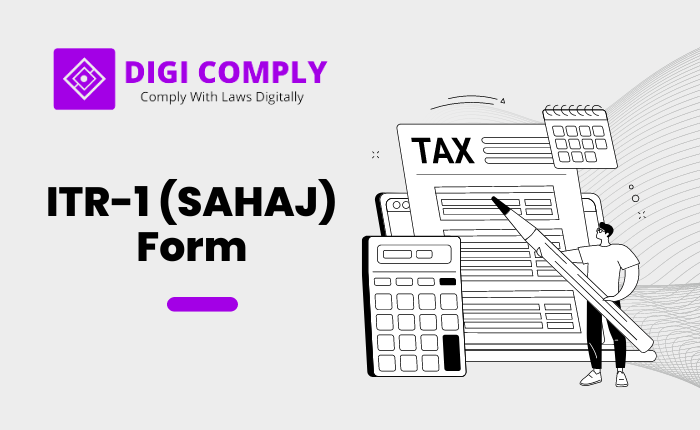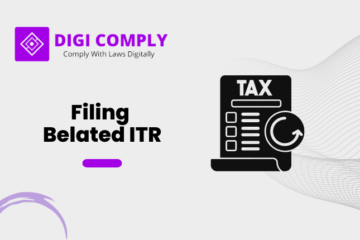Filing income tax returns is an essential responsibility for every eligible taxpayer in India. It helps individuals comply with the law and contribute to the smooth functioning of the country’s taxation system. To simplify the process, the Indian government has introduced various forms, one of which is the ITR-1 (SAHAJ) form. The ITR-1 form is designed specifically for individuals with relatively straightforward income sources, particularly salaried individuals. In this blog, we will delve into the eligibility criteria and applicability of the ITR-1 (SAHAJ) form in India, providing you with a comprehensive understanding of its usage.
What is the ITR-1 (SAHAJ) Form?
The ITR-1 (SAHAJ) form is a simplified income tax return form provided by the Income Tax Department of India. It is primarily meant for resident individuals who have income from salaries, one-house property, and other sources (excluding lottery winnings and income from races). The form caters to individuals with a total income of up to Rs. 50 lakh. The ITR-1 form aims to streamline the filing process for those with relatively straightforward financial affairs, making it easier and more accessible for them to meet their tax obligations.
Eligibility for Filing ITR-1 (SAHAJ) Form:
To determine whether you are eligible to file your income tax return using the ITR-1 (SAHAJ) form, you need to meet the following criteria:
1. Resident Individual: The ITR-1 form is applicable only to resident individuals in India. Non-resident individuals and Hindu Undivided Families (HUFs) cannot use this form. If you fall under the category of a resident individual, you are on the right track to determining your eligibility for using the ITR-1 form.
2. Income Sources: The ITR-1 (SAHAJ) form is suitable for individuals who derive income from specific sources. These sources include:
a. Salary or Pension: If you earn income from a salary or receive a pension, you meet one of the key criteria for using the ITR-1 form. This includes income from your employment, such as wages, allowances, bonuses, or any other remuneration.
b. One House Property: Individuals who own a single property, other than those held as stock-in-trade or rented out, can use the ITR-1 form. If you have income from house property, such as rental income or deemed rental income, and you own only one house, you meet the eligibility requirements.
c. Other Sources: The ITR-1 form covers individuals who have income from other sources. This includes interest income from bank accounts, fixed deposits, or bonds, as well as dividend income or family pension. However, it’s important to note that income from lottery winnings or races is excluded from the ITR-1 form.
3. Total Income Limit: The ITR-1 (SAHAJ) form is applicable to individuals whose total income does not exceed Rs. 50 lakh. If your total income, which includes income from all sources mentioned above, is above this threshold, you will need to consider using a different ITR form.
Restrictions on Using ITR-1 (SAHAJ) Form:
While the ITR-1 (SAHAJ) form is suitable for individuals meeting the eligibility criteria mentioned above, there are certain cases where it cannot be used. The following are the key restrictions for using the ITR-1 form:
1. Non-Resident Status: Non-resident individuals, i.e., those who do not meet the criteria for being a resident as per the Income Tax Act, are ineligible to use the ITR-1 form. Non-residents must use the appropriate form designated for their residency status.
2. Multiple House Properties: If you own more than one house property, the ITR-1 form is not applicable to you. Individuals with multiple house properties, regardless of whether they are let out or held as stock-in-trade, should consider using the ITR-2 or other relevant forms based on their specific circumstances.
3. Business Income: The ITR-1 (SAHAJ) form is not suitable for individuals who have income from business or profession. This includes freelancers, consultants, self-employed individuals, or those who run their own businesses. If you derive income from business activities, you must choose the appropriate form based on the nature and complexity of your business income.
When filing the ITR-1 (SAHAJ) form, it’s important to avoid certain common mistakes to ensure accuracy and prevent any potential issues. Here are some common mistakes to avoid:
1. Choosing the wrong form: Ensure that you are eligible to file the ITR-1 form. This form is applicable for individuals with income from salary, one house property, and other sources such as interest income. If you have income from business or profession, capital gains, or more than one house property, you may need to use a different form.
2. Incorrect personal details: Double-check that you have entered your name, PAN (Permanent Account Number), contact details, and bank account details accurately. Mistakes in personal information can lead to issues in processing your return.
3. Not reporting all sources of income: Include all your income sources while filing the ITR-1 form. This includes salary income, income from house property, interest income, and any other taxable income. Failing to report all income can lead to penalties or scrutiny by tax authorities.
4. Inaccurate calculation of income: Ensure that you calculate your income correctly, including any deductions or exemptions you are eligible for. Common deductions include those under Section 80C (such as investments in PPF, ELSS, etc.), Section 80D (health insurance premium), and Section 24 (home loan interest). Incorrect calculations may result in underpayment or overpayment of taxes.
5. Not reconciling TDS details: Verify that the TDS (Tax Deducted at Source) details mentioned in your Form 26AS match the details mentioned in your ITR-1 form. If there are any discrepancies, you should rectify them by contacting the deductor or the relevant authorities.
6. Omitting disclosure of foreign assets: If you hold any foreign assets, such as bank accounts, properties, or investments, make sure to disclose them in the appropriate section of the form. Failure to disclose foreign assets can lead to penalties and legal consequences.
7. Ignoring the verification process: After completing the form, don’t forget to sign and verify it. You can e-verify your return using methods such as Aadhaar OTP, net banking, or by sending a physical copy to the Centralized Processing Center (CPC) within the specified time frame.
8. Not keeping supporting documents: It’s crucial to maintain proper records and supporting documents for all the information provided in your ITR-1 form. These documents may include salary slips, Form 16, bank statements, investment proofs, and rent receipts, among others. Keeping accurate records will help you substantiate your claims in case of any scrutiny or audit.
Filing income tax returns in India is a crucial obligation for taxpayers, and the ITR-1 (SAHAJ) form serves as a simplified option for individuals with specific income sources. By understanding the eligibility criteria and applicability of the ITR-1 form, taxpayers can ensure compliance with the Income Tax Department’s requirements. It is essential to accurately assess your income sources, total income, and other factors to determine if the ITR-1 form is appropriate for you. Remember, timely and accurate filing of tax returns helps individuals fulfill their legal obligations and contributes to the efficient functioning of the Indian taxation system.
If You have any queries then connect with us at support@legalsuvidha.com or info@digicomply.in & contact us & stay updated with our latest blogs & articles





